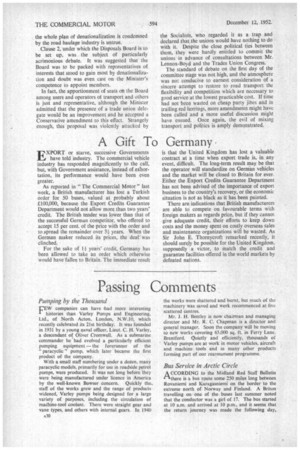Passing Comments _
Page 32

Page 33

If you've noticed an error in this article please click here to report it so we can fix it.
Pumping by the Thousand
FEW companies can have 'had more interesting histories than Varley Pumps and Engineering, Ltd., of North Acton, London, N.W.10, which recently celebrated its 21st birthday. It was founded in 1931 by a young naval officer, Lieut. C. H. Varley, a descendant of Oliver Cromwell. As a submarine commander he had evolved a particularly efficient pumping equipment — the forerunner of the " paracyclic " pump, which later became the first product of the company.
With a small staff numbering under a dozen, many paracyclic models, primarily for use in roadside petrol pumps, were produced. It was not long before 'they were being manufactured under licence in America by the well-known Bowser concern. Quickly the staff of the works grew and the range of products widened, Varley pumps being designed for a large variety of purposes, including the circulation of machine-tool coolant. There were straight gear and vane types, and others with internal gears. In 1940
the works were shattered and burnt, but much of the machinery was saved and work recommenced at five scattered centres.
Mr. J. H. Bentley is now chairman and managing director and Mr, R. C. Chapman is a director and general Manager. Soon the company will be moving to new works covering 65,000 sq. ft. in Ferry Lane. Brentford. Quietly and efficiently, thousands of Varley pumps are at work in motor vehicles, aircraft and machine tools and in many other products forming part of our rearmament programme.
Bus Service in Arctic Circle
CCORDING to the Midland Red Staff Bulletin 'there is a bus route some 250 miles long between Rovaniemi and Karagasniemi on the border to the extreme north of Norway and Finland. A Briton travelling on one of the buses last summer noted that the conductor was a girl of 17. The bus started at 10 a.m. and arrived at 10 p.m., and it seems that the return journey was made the following day,
starting at 5 a.m. and finishing at 5 p.m., the driver and the clippie having the third day off. Normal cruising speed is 50 m.p.h., but there are stops where passengers are given time to enjoy coffee or soup. During this particular trip, only three other vehicles were encountered on the whole journey.
How Static Charges Develop
MANY have been the suggestions as to how vehicles develop static charges of electricity. At Fort Dunlop much research has been conducted in this connection. It was here, in 1934, that it was found possible to make rubber products with an electrical resistance of less than 100 ohms, without I altering any of the physical properties of the rubber. This led the way to the development of " conducting " rubber tyres which would generally earth any' static charge. These are frequently fitted to public .service vehicles.
The explanation of the charging phenomenon is that various parts of the tread of the tyre constantly shuffle against the road surface. If road and tyre be dry and the road smooth, the separation after this intimate contact leads to electrification of both tyre and road. When a particular point on the tyre tread pattern is close to the road, the capacity of the condenser, which in effect is formed, is high and the voltage low. As the wheel revolves and the point moves farther away from the road, the capacity effect falls and the voltage rises.
This process proceeds continuously and the voltage built up passes to the body by induction and conduction. The voltage may be very high but the 'quantity of electricity generated is invariably quite small. Any shock is only momentary and comparable to that obtained by touching a sparking plug on a running engine.
Phosphating Decreases Wear
gPL1NED layshafts for synchromesh gearboxes and steel buttons to take king-pin thrust on passenger vehicles and Comet 90 goods models are now being phosphated by Leyland Motors, Ltd., to improve lubrication. The phosphate coating absorbs oil and. retains it for long periods, and research has demonstrated that wear is greatly reduced.
The parts are first de-greased and rinsed in hot water. Then follows a 15-minute dip in the chemical bath and a second rinse. Immersion in oil is next made. The phosphate coating varies in thickness from 0.0002-0.0003 in.




























































































